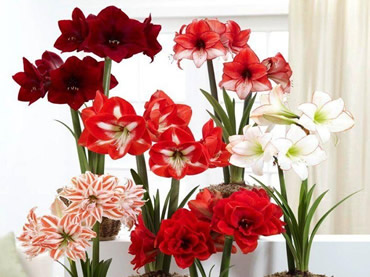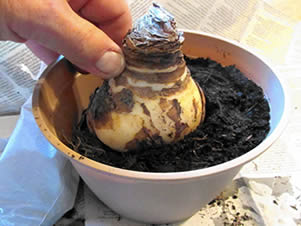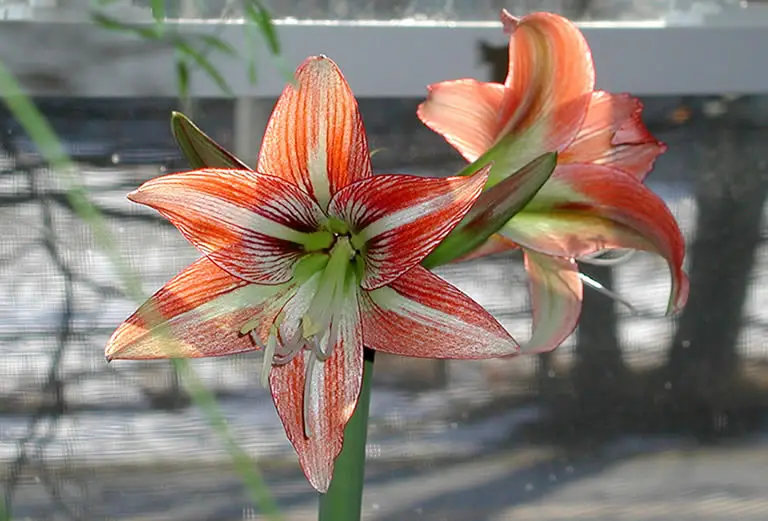Many amaryllis owners will dispose of the bulb when their plant has finished blooming and it loses all of its foliage. When they are left with just a bare bulb it is understandable why some amaryllis owners think the plant is dead but disposing of the bulb is a mistake. Amaryllis is a perennial plant meaning it comes back every year with fresh blooms.
When all the foliage disappears it is merely because the bulb has gone dormant in order to rest.
Table of Contents
Amaryllis naturally bloom once per year
So, if you should not dispose of your amaryllis bulb when all the foliage falls off does this mean you can reuse it … does amaryllis rebloom?
Amaryllis rebloom every year. Amaryllis blooms once per year before going dormant when the bulb will rest and gather resources. The following year the same plant will bloom again.
If amaryllis is given the basic care it needs it will continue to rebloom every year because it is a perennial plant.
Amaryllis will flower more than once per year only if they are forced to do so
Now that you know amaryllis will bloom every year you may be wondering how many times it blooms before the bulb goes dormant. Do amaryllis flower more than once?
Amaryllis are perennials that bloom every year. They naturally only produce flowers once per year though it is possible to force amaryllis to flower more than once per year by manipulating its growth and dormancy cycle.
I have outlined in a previous article that it is possible to force amaryllis to bloom twice in a 12 month period. However, if left to its natural growth cycle amaryllis will only bloom once in a 12 month period.

Although you can force reblooming I do not recommend doing this as an amaryllis bulb should be allowed to rest after blooming has finished. As I outlined in this article, an amaryllis bulb requires 2 -3 months of rest before it enters a new growth cycle. Forcing the bulb to continually enter new growth cycles will exhaust it and lead to an unhealthy plant with lackluster blooms.
Forcing reblooming continually, and not allowing the bulb sufficient rest, can also lead to drooping leaves and eventually the plant may refuse to bloom at all. This will also shorten the life of the plant.
Luckily, there is an easy alternative to forced reblooming, if you want more than one yearly amaryllis flowering.
Because indoor amaryllis can be cultivated to bloom in any season (outdoor amaryllis are a different matter) it is possible to have 2 or more plants, each with a different bloom time. Not only does this mean you can have multiple yearly flowerings without overworking a single bulb, it also means you can have different species of amaryllis with different colored blooms.
For details on how to get your amaryllis plants to have different bloom times read my article about amaryllis growth stages as it contains all the steps you need to ensure your amaryllis flowers in the exact season you want it to.
Don’t throw away your amaryllis bulb after blooming!
Many amaryllis owners will dispose of an amaryllis bulb when it loses all its foliage. This is a mistake.
You can keep amaryllis for next year. Amaryllis is a perennial, meaning it lives more than two years. When blooming is finished an amaryllis bulb will lose all its foliage and go dormant for 2 – 3 months before entering a new growth cycle which eventually leads to another bloom.
Amaryllis is an easy-care succulent that requires very little attention other than regular watering and some fertilization during its growth stages – see our amaryllis watering guide.
Amaryllis is a perennial, but unlike many other perennials that only live a few years, amaryllis can live a very long time. In fact, this succulent has been known to last up to 70 years with there currently being some amaryllis plants in the US that date back to the 1950’s. This is a hardy plant that is capable of outliving the person who plants it. So, don’t dispose of your amaryllis bulb, keep it for use next year and the year after and the years after that.
Amaryllis bulbs come back every year to produce new foliage & blooms
Even though an amaryllis bulb will lose all its foliage after blooming has finished, it isn’t dead.
Amaryllis bulbs come back every year because amaryllis is a perennial. Some plants are known to be 70 years old. Amaryllis blooms once every year. Afterwards the bulb will go dormant for 2 -3 months after it loses all its foliage. After this rest period the bulb will enter a new growth cycle leading to new foliage growth and it will produce a new bloom the next year.
Do not dispose of an amaryllis bulb when its leaves go yellow and the bulb eventually loses all its foliage. This is a common mistake that many amaryllis owners make.
When they see the leaves fall off the the plant and are left with only a bare bulb they understandably think the plant is dead. It isn’t.
The bulb requires a few months of rest while it continues to gather resources for its next growth cycle.

When the bulb rests there is no need to move it. It will happily rest in the same pot in the same position, as it does not require darkness during dormancy.
During dormancy the bulb should be left alone. Do not water or fertilize it.
Once the bulb emerges from its dormant state, and starts to show signs of new foliage growth, I recommend repotting it in fresh soil and watering it.
If you use the type of potting mix that I recommend, this miracle-gro mix is great for this, then you will not need to fertilize the plant for several weeks as there will be more than enough nutrients in the soil.
When you see signs of straight flower stalks, or after about 4 – 6 weeks, you can fertilize your amaryllis once every 2 weeks.
I personally find that either a good quality slow release succulent feed or a feed with a 10-10-10 ratio of NPK (nitrogen, phosphorus, potassium) works the best with indoor amaryllis.
As a final note I would like to remind you that amaryllis is poisonous and so you should be careful growing this plant if you have pets and/or small children that like to chew on your houseplants (or outdoor plants). I have 5 cats and so I am very careful about where I place my amaryllis.
Also, if you are one of our UK website visitors you may also want to read our guide to growing amaryllis in the UK.

